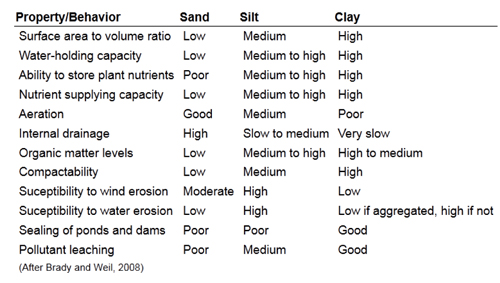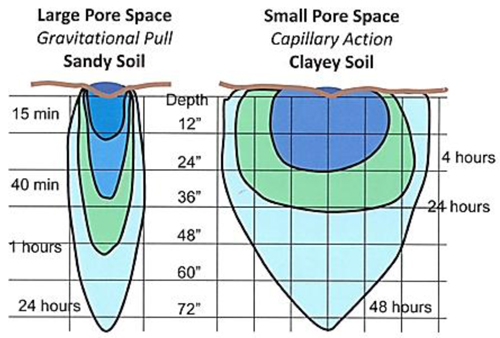Soil type influences irrigation strategy
Soil characteristics play an important role in application of soil amendments, pesticides, fertilizers and water. Irrigation strategy for clay-based soils is much different than the strategy for sand-based soils.
When it comes to irrigation, many growers question how much, how long, how fast and how often they need to irrigate. The answers usually involve a combination of soil characteristics, plant growth stage and weather, however, how fast to apply water is based solely on soil type.
Clay-based soils have small, flat, compact particles with large surface to volume ratios. These soils are often difficult to prepare for planting since they are slippery when wet and hard when dry, making timing for field operations critical to avoid damaging soil structure and getting proper soil tilth for planting. Sand-based soils are at the other end of the spectrum having comparatively large particles with small surface to volume ratios. They are generally easier to prepare for planting and can be worked shortly after significant rainfall. There are good and bad points for each soil type (Table 1).
Table 1. Characteristics of sand, silt and clay soils. Brady and Weill, 2008.

For irrigation purposes, it is important to remember water is absorbed and moves slowly through clay soils, but once wet, they retain significant amounts of moisture. Water is absorbed and moves quickly through sandy soils, but they retain very little. This means water applied quickly to clay soil has a tendency to run off rather than move into the soil. Therefore, when irrigating clay soils, water should be applied slowly over a long period but then the site may not need irrigation for several days. Irrigation on sandy soils should be applied quickly but for short periods. Irrigation times on sandy sites should be shorter, otherwise water moves beyond the root zone, becoming unavailable to the plant and contributing to soil leaching. For efficient water use under certain weather conditions, sandy sites may need daily irrigation for short periods. Clay soils have greater capillary (sideways and upward) movement than do sandy soils (Figure 1). Quick water application on sandy soils will contribute to a broader wetting area, providing more soil volume for roots to exploit.
Figure 1. Water spread and penetration time and distance in sandy and clay soils. David Whiting, 2011.

Michigan soils can vary considerably within the same field. Drip systems can be zoned to account for this variation and each zone irrigated according to the predominant soil type. Emitter flow rate can also be selected to accommodate different soil types; with high flow emitters used on sandy sites and low flow emitters on clay sites. Emitter spacing can also be changed with larger spacing on clay soils and shorter spacing on sandy sites. Growers using drip systems should take advantage of these options to maximize water use while minimizing environmental concern. Overhead irrigators do not have this option, so they need to be more aware of the weather and be sure to not saturate the soil, especially if there is a chance of rain. They also should avoid large applications of water shortly after fertilizer or pesticide applications.
Paying attention to soil type and how it should be irrigated will make water applications more efficient and more environmentally safe.



 Print
Print Email
Email



